Olympic Games ceremony
Olympic Games ceremonies of the Ancient Olympic Games were an integral part of these Games; the modern Olympic games have opening, closing, and medal ceremonies. Some of the elements of the modern ceremonies harken back to the Ancient Games from which the Modern Olympics draw their ancestry. An example of this is the prominence of Greece in both the opening and closing ceremonies. During the 2004 Games, the medal winners received a crown of olive branches, which was a direct reference to the Ancient Games, in which the victor's prize was an olive wreath. The various elements of the ceremonies are mandated by the Olympic Charter, and cannot be changed by the host nation. This requirement of seeking the approval of the International Olympic Committee (IOC) includes the artistic portion of opening and closing ceremonies.
| Olympic Games |
|---|
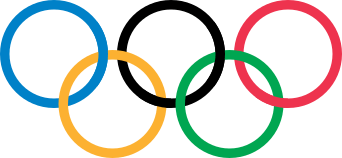 |
| Main topics |
| Games |
The ceremonies have evolved over the centuries. Ancient Games incorporated ceremonies to mark the beginning and ending of each successive game. There are both similarities and differences between the ancient Olympic ceremonies and their modern counterparts. While the presentation of the Games has evolved with improvements in technology and the desire of the host nations to showcase their own artistic expression, the basic events of each ceremony have remained unchanged. The presentation of the Opening and Closing Ceremonies continue to increase in scope, scale, and expense with each successive celebration of the Games, but they are still steeped in tradition. The 2028 Los Angeles Olympics organisers propose that the opening and closing ceremonies will each, for the first time, be staged across two different stadiums.[1]
Ancient forerunners
The Ancient Games, held in Greece from ca. 776 BC to ca. 393 AD,[2] provide the first examples of Olympic ceremonies. The victory celebration, elements of which are in evidence in the modern-day medal and closing ceremonies, often involved elaborate feasts, drinking, singing, and the recitation of poetry. The wealthier the victor the more extravagant the celebration.[3] The victors were presented with an olive wreath or crown harvested from a special tree in Olympia by a boy, specially selected for this purpose, using a golden sickle.[3] The festival would conclude with the victors making solemn vows and performing ritual sacrifices to the various gods to which they were beholden.[3]
There is evidence of dramatic changes in the format of the Ancient Games over the nearly 12 centuries that they were celebrated. Eventually, by roughly the 77th Olympiad, a standard 18-event program was established.[4] In order to open a Games in ancient Greece the organizers would hold an Inauguration Festival. This was followed by a ceremony in which athletes took an oath of sportsmanship. The first competition, an artistic competition of trumpeters and heralds, concluded the opening festivities.[4]
Opening
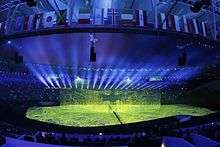
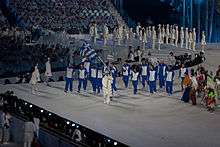

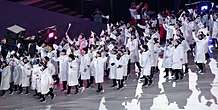
The Olympic opening ceremonies represent the official commencement of an Olympic Games. In recent Olympics, athletic competition began prior to the opening ceremonies. For example, the football competitions for both men and women at the 2008 Summer Olympics began two days prior to the opening ceremonies.[5] The 2014 Winter Olympics then became the first Winter Games to hold competitions before the opening ceremony.[6]
As mandated by the Olympic Charter, various elements frame the Opening Ceremonies of a celebration of the Olympic Games.[7][8] Most of these rituals were canonized at the 1920 Summer Olympics in Antwerp, Belgium.[9]
Artistic program
The artistic program is what creates the idiosyncratic element of each ceremony.[10] Coubertin's initial vision of the Modern Olympics featured both athletic competitions and artistic achievements.[11] As the modern Olympics have evolved into a celebration of sport, it is in the opening ceremonies that one can see the most of Coubertin's ideal. The opening ceremonies are an important ritual of the Olympic games that represent a wide variety of features such as similar qualities and messages that link together local and global issues, as well as cultural similarities at the same scopes.[12] The artistic program of the ceremonies allows the host country to showcase its past and future in a comprehensive way.[12] The ceremonies typically start with the raising of the host country's flag and a performance of its national anthem.[7][8] The host nation then presents artistic displays of music, singing, dance, and theater representative of its culture, history, and the current Olympic game motto.[9] Since the 1980 Summer Olympics in Moscow, the artistic presentations have continued to grow in scale and complexity. The opening ceremony at the Beijing Games, for example, reportedly cost US$100 million, with much of the cost incurring in the artistic portion of the ceremony.[13]
Parade of Nations
The traditional part of the ceremonies start with a "Parade of Nations", during which most participating athletes march into the stadium, country by country. It is not compulsory for athletes to participate in the opening ceremonies. Because some of the first events of the Games may start on the day before, on the day, or the day after the ceremonies, athletes competing in these early events may elect not to participate.
For every Opening Ceremony, each host country has a theme. During the "Parade of Nations", the host country's goal is to represent their cultural identity and to show the world their place in society. For example, in the 2008 Beijing Olympics the theme was “unity”. On May 12, 2008, a devastating earthquake erupted in Sichuan. As the host country, China wanted to remember this tragic event by having Yao Ming, a Chinese basketball legend, walk hand-in-hand with Lin Hao, a nine-year-old boy who saved some of his classmates during the earthquake.[12]
Each country's delegation is led by a sign with the name of their country and by their nation's flag.[7][8] Traditionally, since the 1928 Summer Olympics Greece always enters first and leads the parade due to the historical status as the progenitor of the Olympics, and the host nation enters last.[9][14] All other participating teams enter after Greece and before the host nation, in alphabetical order according to a language selected by the organizing committee for those games, which is usually the dominant language in the area of the host city. Announcers announce each country's name in English, French and the dominant language of the area of the host city, if neither English nor French is the dominant language. Beginning with the 2020 Summer Olympics, the succeeding hosts of the respective Olympic Games (Summer or Winter) will march immediately before the current host in descending order. Therefore (for example), the host nation (Japan) will follow the United States and France respectively as the final three nations to march. Also, the Refugee Olympic Team will now follow Greece as the second team to enter.[15]
In the 2004 Summer Olympics in Athens, the Greek flag led the parade, while the Greek team entered last, as the host nation; Saint Lucia (Αγία Λουκία in Greek) then entered first. In the 1992 Summer Olympics in Barcelona, both Spanish and Catalan were official languages of the games, but due to the political sensitivity surrounding the use of Catalan, the nations entered in French alphabetical order. In the first three games taking place in Japan, due to Japanese pronunciation issues, the nations entered in English alphabetical order instead of Japanese characters. In the upcoming 2020 Summer Olympics, Japanese will be used as an official language as teams will be ordered in a traditional Katakana script. In the 2008 Summer Olympics, teams were ordered by the number of strokes in the Chinese translation of the team name; this is expected to happen again in the 2022 Winter Olympics.[16] In the 2010 Winter Olympics, teams entered in English alphabetical order, although the languages of the Olympics are also the languages of the host country, Canada, because English is the more dominant of the two in Vancouver and in the host province of British Columbia. In the 1980 Summer Olympics and the 2014 Winter Olympics, the countries entered in the Cyrillic alphabetical order, which is the Russian language's official script, while in the 1988 Summer Olympics and the 2018 Winter Olympics, the countries entered in the Hangul alphabetical order, which is Korean language's official script.
Traditional events
After all nations have entered, the President of the Organizing Committee makes a speech, followed by the IOC president. At the end of his speech, he introduces the representative or head of state of the host country who officially declares the opening of the Games. Despite the Games having been awarded to a particular city and not to the country in general, the Olympic Charter presently requires the opener to be the host country's head of state.[17] However, there have been many cases where someone other than the host country's head of state opened the Games. The first example was at the Games of the II Olympiad in Paris in 1900, which had no opening ceremony before as part of the 1900 World's Fair. There are five examples from the United States alone in which the Games were not opened by the head of state.[18]
The Olympic Charter provides[17] that the person designated to open the Games should do so by reciting whichever of the following lines is appropriate:
- If at the Games of the Olympiad (Summer Olympics): I declare open the Games of [name of the host city] celebrating the [ordinal number of the Olympiad] Olympiad of the modern era.
- If at the Winter Games: I declare open the [ordinal number] Olympic Winter Games of [name of the host city].
Before 1936, the opening official would often make a short welcoming speech before declaring the Games open. However, since 1936, when Adolf Hitler opened both the Garmisch Partenkirchen Winter Olympics and the Berlin Summer Olympics, the openers have used the standard formula. Recent editions of the Winter Games have seen a trend of using the first version instead of the second, which happened in both the 2002 and 2010[19] Winter Games. There have been seven further exceptions to the rule:
- In 1976, Elizabeth II, as Queen of Canada, opened the Montreal Olympics (first in French followed by the English) with:
I declare open the Olympic Games of 1976, celebrating the XXI Olympiad of the modern era.[20]
- In 1984, U.S. President Ronald Reagan opened the Los Angeles Summer Olympics with:
Celebrating the XXIII Olympiad of the modern era, I declare open the Olympic Games of Los Angeles.[21]
- In 2002, U.S. President George W. Bush opened the Winter Olympics in Salt Lake City, which took place five months after the September 11 attacks, with:
On behalf of a proud, determined and grateful nation..., then the standard opening formula followed.
- In 2004, President of the Hellenic Republic, Konstantinos Stephanopoulos open the 2004 Summer Olympics in Athens by speaking in Greek:
I declare, the opening of the Olympic Games in Athens...and the celebration of the XXVIII Olympiad of the modern era.
- In 2006, President of the Italian Republic Carlo Azeglio Ciampi opened the Winter Olympics in Torino by speaking in Italian:
I declare open, in Turin, the celebration of the XX Winter Olympic Games.[22]
- In 2008, Chinese President Hu Jintao opened the Summer Olympics in Beijing by speaking in Mandarin:
I declare, the XXIX Olympic Games of Beijing ... open![23]
- In 2012, Elizabeth II, as Queen of the United Kingdom, opened the London Summer Olympics with the same fashion in English, making it the second time that she opened the Games.[24]
- In 2016, Brazilian Acting President Michel Temer opened the Rio de Janeiro Summer Olympics in Brazilian Portuguese, contrary to usual practice, he was not introduced at the beginning of the ceremony, nor was he introduced at the end of President Bach's speech, with:
After this wonderful show, I declare open the Rio Olympic Games, celebrating the XXXI Olympiad of the Modern Era.[25]
Next, the Olympic flag is carried horizontally (since the 1960 Summer Olympics) into the stadium and hoisted as the Olympic Hymn is played. The Olympic Charter states that the Olympic flag must "fly for the entire duration of the Olympic Games from a flagpole placed in a prominent position in the main stadium".[17] At most games, the flag has been carried into the stadium by prominent athletes of the host nation, but in 2012, it was carried by an international group of athletes and non-athletes famous for promoting Olympic values, including Muhammad Ali as a symbolic flag-bearer.
The flag bearers of all countries then circle a rostrum, where one athlete of the host nation (since the 1920 Summer Olympics), and one judge of the host nation (since the 1972 Summer Olympics) speak the Olympic Oath, declaring they will compete and judge according to the rules of their respective sport.[17] Since the 2012 Summer Olympics in London, continuing with the tradition started at the 2010 Summer Youth Olympics a coach from the host nation speaks out the Olympic Oath. For the 2018 Winter Olympics in PyeongChang, the three oaths are merged into one as the Unified Oath where one athlete, judge, and coach recite one line of the oath respectively before the athlete finishes it.
Olympic flame
.jpg)
Finally, the Torch is brought into the stadium, passed from athlete to athlete during the torch relay, until it reaches the last carrier; often a well-known athlete from the host nation, who lights the fire in the stadium's cauldron.[7][8] Under IOC rules, the lighting of the Olympic cauldron must be witnessed by those attending the opening ceremony, implying that it must be lit at the location where the ceremony is taking place. Another IOC rule states that the cauldron should be witnessed outside by the entire residents of the entire host city. This was made evident during the opening ceremony for the 2010 Games in Vancouver. The venue chosen as the Olympic Stadium was BC Place, which at the time was an air-supported domed stadium. Since there was no way the cauldron could be displayed outside and also be seen at the stadium, two cauldrons were used. For the first torch lighting inside the stadium the organizers chose three-time speed skating medalist Catriona Le May Doan, Canadian Senator Nancy Greene, who won two medals for Canada at the 1968 Games, NBA star Steve Nash, a native of nearby Victoria, and hockey legend Wayne Gretzky, to each light one of four arms of the torch. Notably, Le May Doan's arm failed to rise; this was later rectified during the closing ceremony when she got a second chance to light her part of the torch and succeeded.
After the official conclusion of the Opening Ceremony, Gretzky was whisked away to a waiting car which took him to the secondary cauldron. Once there, he lit it to correspond with the tradition of Olympics past.
During the 2012 Summer Olympics in London, the cauldron located inside Olympic Stadium (London) was not visible from outside of the stadium. The image of the lit cauldron was projected on the stadium's rooftop screens during the first week of competition,[26] and live footage was available to all broadcast right holders.[26] See List of 2012 Summer Olympics broadcasters.
Doves
.jpg)
Beginning at the post–World War I 1920 Summer Olympics, the lighting of the Olympic flame was followed by the release of doves, symbolizing peace.[27] (Experienced athletes brought newspapers to cover themselves because of the birds' droppings.)[28] The release was discontinued after several doves perched themselves at the cauldron's rim and were burned alive in the Olympic flame during the opening ceremony of the 1988 Summer Olympics in Seoul.[27] It was later replaced with a symbolic release of doves after the flame has been lit.[7][8]
In the 2000 ceremony, a dove image was projected on an enormous white cloth held by the athletes on the stadium floor. In 2004, an LED screen was used. In 2006, acrobats formed the shape of a dove. The 2008 ceremony had yellow fireworks representing doves. In 2010, dove figures were projected on the stage floor. The 2012 ceremony had bicyclists with dove-wings, lit by LEDs. In the 2014 ceremony several dancers, holding strands of blue LED lights, danced on the shape of a dove projected on the stadium floor. In the 2016 ceremony, children with dove shaped kites were seen running with the first Olympic Laurel winner, Kipchoge Keino.
Medal presentation

After each Olympic event is completed, a medal ceremony is held. The Summer Games would usually conduct the ceremonies immediately after the event at the respective venues, whereas the Winter editions would present the medals at a nightly victory ceremony held at a medal plaza, excluding the most of indoor events. A three–tiered rostrum is used for the three medal winners, with the gold medal winner ascending to the highest platform, in the centre, with the silver and bronze medalists flanking. The medals are awarded by a member of the IOC.[29] The IOC member is usually accompanied by a person from sports federation governing the sport (such as IAAF in athletics or FINA in swimming), who presents each athlete with a small bouquet of flowers. When the Games were held in Athens in 2004, the medal winners also received olive wreaths in honor of the tradition at the Ancient Olympics. For the Rio Games in 2016, the flowers were replaced by a small 3D model of the Games' logo and Pyeongchang Games in 2018 a stuffed animal. After medals are distributed, the flags of the nations of the three medalists are raised. The flag of the gold medalist's country is in the centre and raised the highest while the flag of the silver medalist's country is on the left facing the flags and the flag of the bronze medalist's country is on the right, both at lower elevations than the gold medalist's country's flag.
The flags are raised while the national anthem of the gold medalist's country plays.[30] Citizens of the host country also act as hosts during the medal ceremonies. They aid the officials who present the medals and act as flag bearers.[31]
Strict rules govern the conduct of athletes during the medal ceremony. For example, they are required to wear only pre-approved outfits that are standard for the athlete's national Olympic team. They are not allowed to display any political affiliation or make a political statement while on the medal stand.[17] The most famous violation of this rule was the Black Power salute of Tommie Smith and John Carlos at the 1968 Summer Olympics in Mexico City.
For their actions, IOC president Avery Brundage demanded their expulsion from the Olympics.[32] After the United States Olympic Committee (USOC) refused to do so, Brundage threatened to remove the entire United States track and field team from the Olympics. Following this, the USOC complied, and Smith and Carlos were expelled.[33]
As is customary, the men's marathon medals (at the Summer Olympics) or the men's 50 km (31.07 mi) and women's 30 km (18.64 mi) cross-country skiing medals (at the Winter Olympics) are presented as part of the Closing Ceremony, which take place on the penultimate and the last days, in the Olympic Stadium, and are thus the last medal presentation of the Games.
Closing
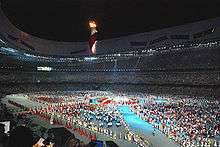
.jpg)
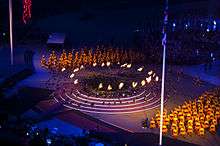
In contrast to the opening ceremony, many elements of the Olympic closing ceremonies gradually developed more by tradition than official mandate.[34]
Like the opening ceremony, the closing ceremony begins with the raising of the host country's flag and a performance of its national anthem.[34] Then the host country presents an artistic program similar to the opening ceremony though it is considered shorter than the opening. Then after the flame is extinguished, there would be a party for the athletes featuring some of the host country's music culture
The traditional part of the closing ceremony starts with the "Parade of Flags",[34] where flag bearers from each participating country enter the stadium in single file, with the Greek flag in the lead and the host nation's flag bringing up the rear. Behind them march all of the athletes without any distinction or grouping by nationality. This "Parade of Athletes,"[34] the blending of all the athletes, is a tradition that began during the 1956 Summer Olympics at the suggestion of Melbourne schoolboy John Ian Wing, who thought it would be a way of bringing the athletes of the world together as "one nation." Prior to the 1956 Games, no Olympic Team had ever marched in the closing ceremony of the Modern or the Ancient Games. It was the very first International Peace March ever to be staged.[35][36] (In 2006, the athletes marched in with their countrymen, then dispersed and mingled as the ceremonies went on.) The Winter Olympics followed suit in Squaw Valley 1960.
After all the athletes enter the stadium, the final medals ceremony of the Games is held. The organizing committee of the respective host city, after consulting with the IOC, determines which event will have its medals presented.[34] During the Summer Olympics, this is usually the men's marathon.[34] Traditionally, the men's marathon is held in the last hours of competition on the last day of the Olympics, and the race is won just before the start of the closing ceremony. However, recent Summer Olympiads in Atlanta, Athens, Beijing, London, and Rio staged the marathon in the early morning due to heat problems in the host city. Since the 2006 Winter Olympics, the medals for the men's 50 km cross-country skiing event were presented at the closing ceremony. The medallists national flags are then hoisted and the national anthem of the gold medallist's country is played.
The newly elected members of the IOC Athletes' Commission then present a bouquet of flowers to a representative of the volunteers, as a thank you to them for their work during the Games.[34]
Next, two other national flags are hoisted on flagpoles one at a time while the corresponding national anthems are played: the flag of Greece to again honor the birthplace of the Olympic Games, and the flag of the country hosting the next Summer or Winter Olympic Games.[34] "Hymn to Liberty", the national anthem of Greece, has been performed at every closing ceremony of the Olympic Games.[37] In Moscow, Soviet Union, during the 1980 Summer Olympics boycott in protest of the Soviet invasion of Afghanistan, the flag raised to represent the next games host was that of the City of Los Angeles instead of the flag of the United States, a break from the tradition that was initiated by the host nation.[38] In Sydney and Athens, two Greek flags were raised because Greece was the next games host (in 2000) and in 2004, because Greece was hosting the games. Then, while the Olympic Hymn is played, the Olympic flag that was hoisted during the opening ceremony is lowered from the flagpole and carried from the stadium.[34]
In what is known as the Antwerp Ceremony (because the tradition began at the Antwerp Games), the mayor of the city that organized the Games transfers a special Olympic flag to the president of the IOC, who then passes it on to the mayor of the city hosting the next Olympic Games.[17] The receiving mayor then waves the flag eight times. There are four such flags:
- The Antwerp flag was presented to the IOC at the 1920 Summer Olympics by the city of Antwerp, Belgium, and was passed on to the next organizing city of the Summer Olympics through the 1984 Games in Los Angeles, California, United States.
- The Oslo flag was presented to the IOC at the 1952 Winter Olympics by the city of Oslo, Norway, and is passed on to the next organizing city of the Winter Olympics.
- The Seoul flag was presented to the IOC at the 1988 Summer Olympics by the city of Seoul, South Korea as a replacement for the Antwerp flag. This flag was used until the 2012 Games in London, England.
- The Rio flag was presented to the IOC at the 2016 Summer Olympics by the city of Rio de Janeiro, Brazil as a replacement for the Seoul flag. It'll be passed on to the next organizing city of the Summer Olympics.
This tradition was modified slightly at the 2006 Winter Games in Turin, Italy. The flag was passed from Sergio Chiamparino, the mayor of Turin, to Sam Sullivan, the mayor of Vancouver, British Columbia, Canada. Mayor Sullivan, who is a quadriplegic, waved the flag by holding it in one hand and swinging his motorized wheelchair back and forth eight times.[39]
This portion of the ceremony actually took place at the opening ceremony until the 1984 summer games and the 1988 winter games.[40]
The next host nation then introduces itself with artistic displays of dance and theater representative of that country or city. This tradition began with the 1976 Games.
Afterwards, the President of the Organizing Committee makes a speech. The IOC President then makes a speech before closing the Olympics by saying:
And now, in accordance with tradition, I declare the Games of the [ordinal number of Summer Olympics] Olympiad/[ordinal number of Winter Olympics] Olympic Winter Games closed; and call upon the youth of the world to assemble four[lower-alpha 1] years from now in [name of next host city] to celebrate the Games of the [subsequent ordinal number of Summer Olympics] Olympiad/[subsequent ordinal number of Winter Olympics] Olympic Winter Games.[41][42][43][44]
Finally, the Olympic flame is extinguished, marking the end of the Games.[34]
Notes
- This part of the declaration may vary if the next Olympic Games is not scheduled for four years hence. The next Winter Games after the 1992 Winter Olympics were two years later, in 1994, and the declaration was modified accordingly. The 2020 Summer Olympics have been postponed to 2021 due to the coronavirus (COVID-19) pandemic, three years before the 2024 Summer Olympics.
References
- Wharton, David (16 January 2017). "L.A. organizers propose linked, simultaneous Olympic ceremonies for Coliseum, Inglewood stadium". Los Angeles Times. Retrieved 25 August 2017.
- "Ancient Olympic Games". The Olympic Movement. Retrieved 2010-02-15.
- Swaddling, Judith (1999). The Ancient Olympic Games. University of Texas Press. pp. 90–93. ISBN 0-292-77751-5.
- Howell, Maxwell L. (1975). "The Ancient Olympic Games:A Reconstruction of the Program". San Diego State University. Cite journal requires
|journal=(help) - "Complete Olympic Schedule". USA Today. 2008-08-10. Retrieved 2008-12-30.
- Sarkar, Pritha (2012-03-29). "Figure skating-New team event at Sochi Olympics will begin early". Reuters. Retrieved 2013-01-05.
- "Fact sheet: Opening Ceremony of the Summer Olympic Games" (PDF). International Olympic Committee. October 2014. Retrieved 2016-08-23.
- "Fact sheet: Opening Ceremony of the Winter Olympic Games" (PDF). International Olympic Committee. October 2014. Retrieved 2016-08-23.
- "The development of the Games – Between festival and tradition" (PDF). The Modern Olympic Games (PDF). International Olympic Committee. 2009-09-12. p. 5. Retrieved 2012-08-13.
- Arning, Chris (2013), "Soft Power, Ideology and Symbolic Manipulation in Summer Olympic Games Opening Ceremonies: A Semiotic Analysis", Social Semiotics, 23 (4): 523–544, doi:10.1080/10350330.2013.799008
- de Coubertin, Pierre (1997). Olympic Memoirs. International Olympic Committee. ISBN 92-9149-015-6.
- Chen, Chwen Chwen; Colapinto, Cinzia; Luo, Qing (2012), "The 2008 Beijing Olympics Opening Ceremony: Visual Insights into China's Soft Power", Visual Studies, 27 (2): 188–195, doi:10.1080/1472586x.2012.677252
- "Beijing Dazzles: Chinese History, on Parade as Olympics Begin". Canadian Broadcasting Centre. 2008-08-08. Retrieved 2009-01-10.
- Athletes Parade-Opening Ceremony London 2012 Olympics on YouTube
- Morgan, Liam (2019-12-03). "France, United States and Refugee team given prominent slots in Tokyo 2020 parade". Lausanne: Inside the Games. Retrieved 2020-01-01.
- Walker, Peter (2008-08-08). "Beijing Olympics open with spectacular ceremony". The Guardian. London. Retrieved 2009-01-10.
- "Olympic Charter" (PDF). The International Olympic Committee. 2015. Retrieved 2018-08-27.
- The first case was the St. Louis Games at which David Francis, President of the Louisiana Purchase Exposition, performed the ceremony; nobody had thought of inviting President Theodore Roosevelt. In 1932, the then-Governor of New York Franklin D. Roosevelt, opened the III Olympic Winter Games in Lake Placid. Later that year the Vice President of the United States, Charles Curtis, opened the Games of the X Olympiad in Los Angeles, California, stating, however, that he was doing so on behalf of President Herbert Hoover. In 1960, Vice President Richard Nixon was sent by President Dwight Eisenhower to open the VIII Olympic Winter Games in Squaw Valley, California, and finally, in 1980, Vice President Walter Mondale stood in for President Jimmy Carter to open the XIII Olympic Winter Games, also in Lake Placid.
- "Opening Ceremony: 2010 Winter Games declared open". Vancouver 2010. 12 February 2010. Retrieved 2010-02-19.
- Montreal 1976 Olympics Opening on YouTube
- 1984 LA Opening Ceremonies – Lighting of the Cauldron on YouTube
- Olympic (13 April 2020). "Torino 2006 Opening Ceremony - Full length" – via YouTube.
- Olympic (8 August 2019). "Full Opening Ceremony from Beijing 2008 - Throwback Thursday" – via YouTube.
- Queen Elizabeth Opened London Olympic Games 2012 on YouTube
- Olympic (25 September 2016). "Rio 2016 Opening Ceremony Full HD Replay – Rio 2016 Olympic Games" – via YouTube.
- "London 2012 News". 24 January 2017. Archived from the original on 31 July 2012.
- "When messengers of peace were burnt alive". Deccan Herald. 2004-08-13. Archived from the original on 2004-08-29. Retrieved 2009-01-10.
- Fraioli, Mario (2010-11-29). "The Best Ever: Exclusive Interview With Jim Ryun". Competitor.com. Retrieved 17 March 2014.
- "Olympic Games – the Medal Ceremonies". Encyclopædia Britannica. Retrieved 2009-01-10.
- "Symbols and Traditions". USA Today. 1999-07-12. Retrieved 2009-01-10.
- "Medal Ceremony Hostess Outfits Revealed". China Daily. 2008-07-18. Retrieved 2009-01-10.
- "1968 Black Athletes make silent protest". BBC. 1968-10-17. Retrieved 2009-01-10.
- "Mexico 1968". International Olympic Committee. Retrieved 2009-01-10.
- "Closing Ceremony Factsheet" (PDF). The International Olympic Committee. 2014-09-01. Retrieved 2016-08-23.
- "Baron Pierre de Coubertin had a 'Dream'". www.johnwing.co.uk.
- "Melbourne (Equestrian – Stockholm) 1956". British Olympic Association. Retrieved 2009-01-10.
- "National Anthem". Hellenic Army Academy. Archived from the original on 9 February 2015. Retrieved 30 January 2015.
- "Moscow 1980 — Closing Ceremony — Los Angeles and Moscow's flags in the stadium". Olympic.org. August 3, 1980. Retrieved February 24, 2014.
- Thomas, Andrew (2008-04-18). "Vancouver Mayor Achieves his Dreams with a Big Heart and Mechanical Help". Disabled World. Archived from the original on 2012-07-28. Retrieved 2009-02-15.
- 1980 Summer Olympics opening ceremony
- "Rogge: Torino Games 'truly magnificent'". USA Today. Associated Press. 2006-02-26. Retrieved 2012-08-13.
- "Speech by Jacques Rogge at the Closing Ceremony". Beijing 2008. 2008-08-24. Archived from the original on 2013-04-17. Retrieved 2012-08-13.
- "Vancouver Winter Olympics lowers curtain with joy and sorrow". Xinhuanet. 2010-03-01. Archived from the original on 2012-11-06. Retrieved 2012-08-13.
- "London 2012: Jacques Rogge praises 'happy and glorious' games". The Daily Telegraph. 2012-08-13. Retrieved 2012-08-13.